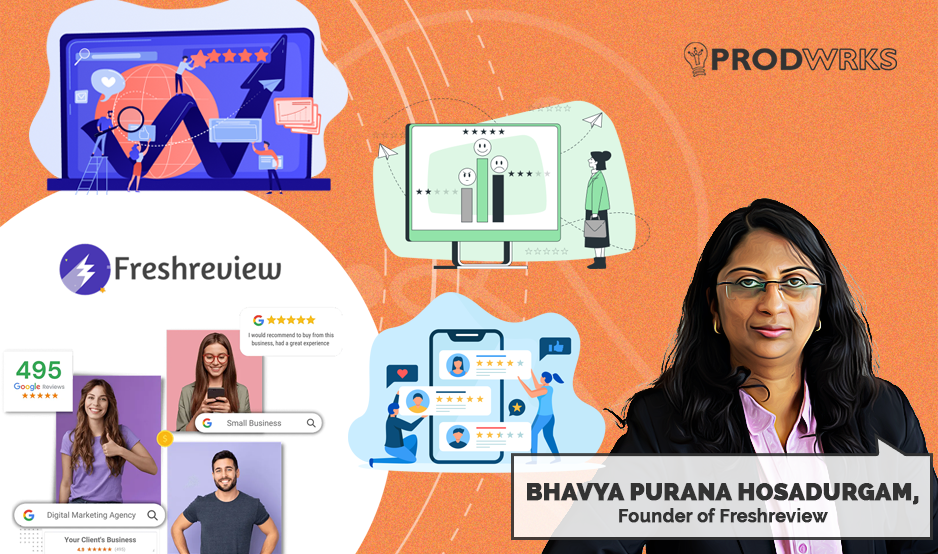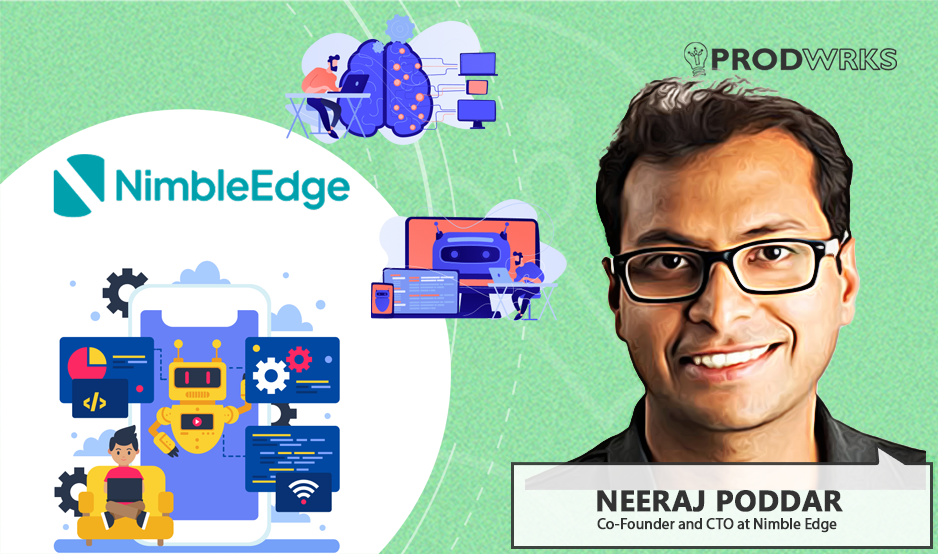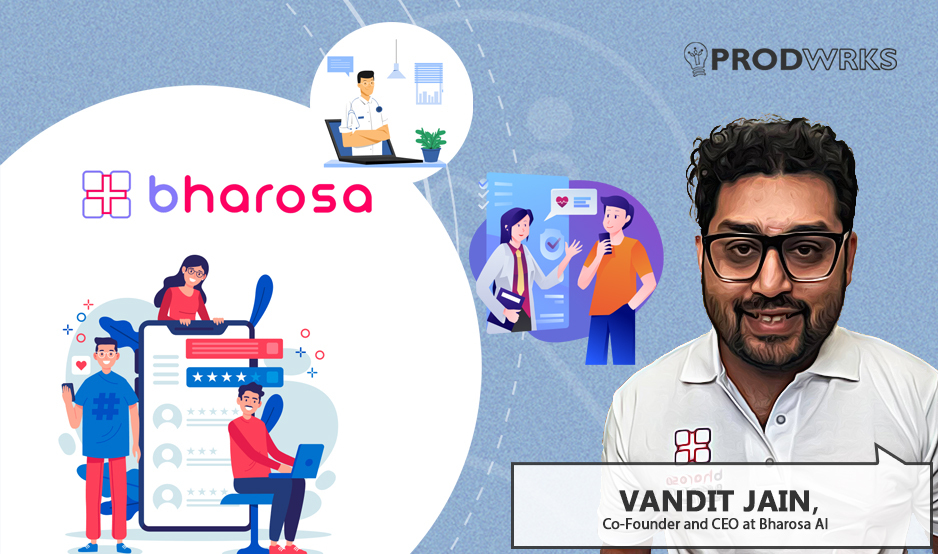
For most founders, an acquisition is the finish line and a moment of triumph. But for Bhavya Purana Hosadurgam, the solo founder of Freshreview, selling the company she had built by spending seven years of her life wasn’t just a strategic move. It was a decision steeped in brutal honesty, a decision shaped by hard-won wisdom, quiet reflection, and a profound sense of letting go.
Freshreview is an AI-powered review management SaaS platform founded by Bhavya in 2019 and recently acquired by GaragePlug, a company that focuses on automotive service digitalization.
But this isn’t your typical startup acquisition story.
In her conversation with ProdWrks, Bhavya candidly shares her product journey, the go-to-market gambles, the pricing pitfalls, and the deeply personal toll of building something from nothing and taking the decision to step away from the venture.
This is a rare, unfiltered look at a solo founder’s journey of building, scaling, and selling a global SaaS product from India.
The Impatient Engineer Who Solved the Reputation Problem
Bhavya says, “Every three years, I used to switch jobs because I felt that my true potential wasn't getting used. At this point, the burgeoning startup ecosystem in Bangalore was impossible to ignore. People were starting up, left, right, and center. Any cafe you go to, there is only startup stuff happening.”
So, she took the startup plunge. Her first step was into IIM Bangalore’s Launchpad program, a sandbox for aspiring entrepreneurs. This led to her selection for the prestigious Women Startup Program, a highly competitive initiative that accepts only 100 founders from lakhs of applicants.
As Bhavya recalibrated her focus to solve a real-world problem, she noticed that the digital landscape was undergoing a significant shift. Google Reviews were transitioning from a nice-to-have into a non-negotiable cornerstone of a business’s online presence. Reputation management was becoming a critical function.
The problem was a tangible pain point she observed firsthand within her own entrepreneurial cohort at IIM.
“I realized that there were a lot of people having really great products, but they were not able to match the bigwigs, just because they did not have sufficient customer reviews,” she explains. And this was the spark. “There's a way to productize this entire thing,” she thought.
She sat down and began to build. After a brief experiment with Flutter, which she found “too abstract,” she settled on a more robust stack: Angular for the front end and Java for the back end. She built the first native version of Freshreview as a micro-SaaS and released it.
This wasn’t about building a unicorn SaaS company from day one. “It was just playing around with the product,” she says.
And then, the moment every founder dreams of happened. It was the ultimate validation, coming not from a friend or a local contact, but from a complete stranger from Australia.
“There was a user in Australia. He found the app on the Play Store and used it. And he said, ‘This is better than 15 other apps that I have tried out,’” Bhavya recalls, the excitement still palpable in her voice. “The user even offered to pay if we release an iOS version. And that was the turning point.”
Global Pivot and Cracking GTM
“The ‘near me’ search term in Google, people only rank on it based on a couple of things,” Bhavya explains. “How optimized is their Google Business Profile? And after their profile is optimized, how often are they getting reviews? You have to rank in the top three if you want to start getting more organic leads.”
“I did some WhatsApp marketing. I tried to have some conversations. It was so uncomfortable to have some conversations with dental clinics in India because they were just comparing this with ‘Arre, per review, paanch rupaye mein ho jaayega kya?’ (Can you do it for five rupees per review?). They were asking for paid, fake reviews.”
It was the very antithesis of Bhavya’s product philosophy.
This experience, combined with learnings from communities like SaaSBoomi and accelerators like Upekha, led to a pivotal strategic decision. “I decided that Indian SMB is not the route to go. It has to be either enterprises, or it has to be global SMB or global mid-market.”
Bhavya turned her focus overseas. The product was never targeted at India again. This was a decision she now reflects on with nuance.
“Hindsight, I kind of felt that maybe at one point in time, I shouldn't have ignored India as a market completely. I should have at least gotten, if not SMBs, larger enterprise customers.”
The COVID Pivot and Launching on Shopify
“All the small businesses shut down. People were stuck in their homes and all the services as a concept got wiped away,” she says.
It was a do-or-die moment. While brick-and-mortar services vanished, another ecosystem was exploding: e-commerce. “Shopify was booming quite a bit,” Bhavya recalls. “And the GTM seemed very straightforward on the Shopify marketplace.”
She pivoted, fast. She and her nascent team built a Shopify version of Freshreview. The response was immediate and overwhelming. “We had about 500-plus users for the product in less than six weeks on Shopify as a platform. That became a game changer.”
But the Shopify ecosystem was also a brutal teacher. The users were a completely different breed from the home service businesses she had targeted before.
“Shopify customers are extremely support-intensive,” Bhavya notes. “They'll try any app for exactly 12 seconds. If they can't figure out how to make it work by then, they will just say, ‘App not working.’ They are extremely ruthless.”
The demands were relentless. Support had to be 24/7, with responses expected within hours. A delayed response could earn a negative review, which was poison for an app’s visibility in the marketplace. The irony was not lost on her. “You’re selling a review management product, and how can your reviews be bad?” she laughs.
This intense pressure forced a radical focus on user experience and making the product more “self-served.”
“I didn't want to get on support calls just because someone could not understand some feature,” she says. Using tools like Microsoft Clarity, her team would obsessively watch user session recordings, identifying every point of friction. “We would look at why a user was at one place, or clicking something too many times... it would become extremely clear.”
Freshreview 2.0
Armed with learnings from both the home service and e-commerce worlds, Bhavya embarked on building Freshreview 2.0. This wasn’t just an update; it was a complete reimagining of the product, designed to be more powerful, flexible, and self-serve from day one.
The product evolution was driven directly by customer needs:
- Multi-Channel Campaigns: Users wanted more than just email. Freshreview added SMS, WhatsApp, and even MMS for the US market, allowing businesses to create sophisticated, multi-day drip campaigns.
- Deep Customization: Businesses wanted to own the experience. Freshreview introduced extensive customization for emails, widgets, and review-request landing pages—from colors and logos to footers and signatures.
- Intelligent Automation: The manual CSV upload was no longer enough. Integrations with platforms like Zapier automated the review collection workflow, making the product stickier.
- AI-Powered Responses: As OpenAI’s APIs became available in 2022, Freshreview integrated AI to help businesses draft optimized campaign content and, crucially, generate intelligent, SEO-friendly responses to incoming reviews.
- Marketing the Wins: Learning from the marketing-savvy e-commerce space, the product evolved to help businesses merchandise their social proof. Users could turn positive reviews into social media posts, videos, and a suite of over five customizable website widgets with just a few clicks.
The product was becoming incredibly powerful. But with power came complexity. It began to serve too many masters.
A Thali for Each ICP, or One Big Khichdi for All?
This single product now catered to multi-location businesses, single-owner SMBs, e-commerce stores, and soon, a new and demanding ICP: marketing agencies.
This is where Bhavya, in her candid reflection, identifies a critical misstep. The product was becoming a ‘khichdi’ (a Hindi word for a dish made by mixing rice, lentils, and various other ingredients). It was becoming everything to everyone, and therefore, not perfectly optimized for anyone. This is a common trap for most startups.
“Adapting a product to different ICPs is not at all good,” she states bluntly. “I think once you try to build a product across more than two ICPs, then it becomes a khichdi app."
“Prasanna puts this as a thali startup. He says, 'Make different thalis. Don't have everything in the same thali.' When I reflect back on it, I feel that a lot of the things that got built into the core product, if we had made it as separate products, it would have probably become easier for GTM.”
“I realized this product is no longer for SMBs,” she says. “It has actually become an enterprise-level product.” This sophistication was great for an acquisition pitch, but it made self-serve sales to the original ICPs increasingly difficult.
The Agency Detour and the Lifetime Deal Trap
“Each home service person is actually working already with a digital marketing agency owner,” she realized. “Why am I competing with digital marketing agencies? Why don't I build something for the agencies?”
“Agencies don't buy subscriptions. Agencies only buy lifetime deals,” Bhavya explains with a weary laugh. She decided to offer an LTD. “Platforms like AppSumo take a hefty 70-80% commission and lock you into years of support for a user base you don't own.”
“The first month is all great,” she says. “Second month onwards, as a founder, you kind of wonder, ‘What's wrong in my life? Why are you still talking to that person who paid you $499 four months ago?’ Fourth month onwards, you usually think that, ‘My God, I should have charged $4,000 for this.’”
The lessons came hard and fast. Bhavya shares that an LTD should be offered on an early, feature-limited version of the product, not a mature, capability-rich one. The LTD product and the subscription product should be hosted separately with different feature sets.
She had built a powerful, feature-rich, enterprise-ready product and was now selling it for a one-time fee. It was an unsustainable GTM strategy for a solo-bootstrapped founder.
The Solo Founder's Fire Walk
Woven through the pivots and product builds is the thread of Bhavya’s personal journey and the immense, often unspoken, struggle of being a solo founder.
“Being a solo founder is really, really hard,” she says. The lack of a co-founder to brainstorm with, to share the crushing lows and celebrate the fleeting highs, took its toll. She describes her journey with a visceral analogy. “It’s like someone has to walk on fire. I did that alone for so many years.”
The relentless grind became normalized. “As a founder, at one point in time, I got used to such a hard life, I just continued living it. And at the end of the day, it's not worth it, because you invest so much time and energy and effort. Yes, you get a lot of benefits, learnings, and all of that, but you make it unnecessarily very hard on yourself.”
The Exit, The Aftermath, and The Unvarnished Lessons
By late 2023, Bhavya found herself at a crossroads. The market was shifting seismically towards AI. “I can’t compete against an AI agent offering the same capability at 5x the price,” she reasoned.
Freshreview had AI capabilities, but it wasn’t a fundamentally agentic platform. “Raising capital would be difficult without that.”
The agency and LTD GTM had proven to be a dead end. The product itself had outgrown its original ICP. The path forward became clear. “It’s better for this product to be a part or a module of a vertical SaaS… rather than trying to sell it individually.”
She found the perfect home for Freshreview with GaragePlug, a vertical SaaS company providing an end-to-end operations platform for the auto repair industry.
Freshreview would be deeply integrated into their workflow, providing a powerful review management module to their existing customers. The product found a home, her team found a home, and the acquisition was completed.

“In all of this, I didn't think about myself,” she admits. “I felt that's where I made a mistake in this entire journey. I did not think enough or give myself enough credit (moral and financial) for what we achieved. I should have done that.”
It’s a poignant and powerful lesson for every founder. In the relentless pursuit of building a company, don’t forget to build a sustainable life for yourself.
When asked what she would do differently if she were to start Freshreview today, her answer is swift and decisive:
- Build with Agentic AI from Day One: “I would build it as an AI agent. It would be agents who would be running everything.”
- Price on Value, Not on Competitors: “The pricing would be outcome-based and shamelessly, I’ll start from probably $1,499 or $2,999 because it’s all AI capability.”
- Go Enterprise-Ready from the Start: “Have some India enterprise customers, conversations, and scale.”
- Stay Laser-Focused on ICP: “To a specific ICP or max two, not more than that.”
Today, Bhavya is in a period of transition. She is intentionally not jumping into her next venture. Instead, she’s doing what she didn’t have the luxury to do for years: learning, exploring, and having conversations. She’s diving deep into AI, not just as a product feature, but as a fundamental new way of working.
Bhavya’s story is a testament to the fact that a successful exit isn’t just about the financial outcome. For founders and product leaders navigating their own complex journeys, Bhavya’s story is a roadmap of pitfalls to avoid and a powerful reminder to be as strategic about your own well-being as you are about your product.



